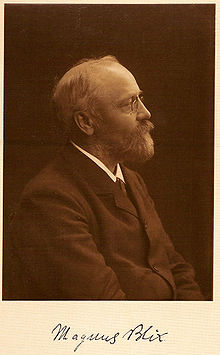Magnus Blix
Magnus Gustaf Blix (born December 25, 1849 in the parish of Säbrå, municipality of Härnösand , † February 14, 1904 in Lund ) was a Swedish physiologist and from 1885 professor at Lund University .
academic career
Blix was enrolled at Uppsala University in 1869 , where he studied medicine from 1870. In 1875 he passed the candidate exam and in 1879 the licentiate . In 1880 Blix graduated as a doctor of medicine and was appointed lecturer in experimental physiology and medical physics in Uppsala that same year . In 1882 Blix was appointed ordinarie laborator at the Physiological Institute at Uppsala University, after having headed the institute since 1876. In 1885 he was appointed professor of physiology and embryology at Lund University . In 1888 he was elected a member of the Leopoldina . In 1899 he became rector of Lund and headed the university until his death in 1904.
Act
Blix dealt in particular with the muscle and sensory physiology and was able to provide important knowledge in these areas. In his treatise Experimentala bidrag tilllösningen af frågan om hudnervernas specifika energi (1883), Blix describes his discovery that the perception of cold and warmth occurs through different nerves . For this proof, Blix received an award from the Swedish Medical Association in 1889.
In his dissertation Oftalmometriska studier (1880), Blix describes an ophthalmometer constructed according to a new principle . In several treatises ( Bidrag till läran om muskelelasticiteten (Uppsala 1874), Till belysning af frågan huruvida värme omsättes till mekaniskt arbete vid muscle contractions (ibid. 1881), Ett bidrag till kännedomen om muskels spänning och det mekanidiska contractions (ibid. 1884) , The length and tension of the muscle ( Scandinavian Archives for Physiology , 1891–95), Studies on Muscle Warmth (ibid. 1901)), Blix used new methods to research the general physiology of muscles. In 1892 Blix was elected to the Royal Swedish Academy of Sciences .
In addition, Hans Blix constructed a number of physiological instruments and devices, including a muscle indicator, which, in addition to the above-mentioned documents, are also described in the treatise Neue Registrierapparate (Pflügers Archives 1902). With an apparatus for measuring heat production during muscle contraction , he created the basis for Archibald Vivian Hill's later work in this area.
Blix made an agreement with his doctor colleague and Professor Carl Magnus Fürst (1854–1935) while he was still alive. The survivor of the two should examine the other's brain after the death. After Hans Blix's death in 1904, Carl Magnus Fürst published the work Professorn i fysiologi vid Lunds Universitet Magnus Blix 'hjärna (Gleerup et al. 1918. 30, IV p .: Ill. Lunds Universitets Årsskrift: Avd. 2, Medicin samtematiska och naturvetenskapliga ämnen ; NF, 14.3.) And presented his investigations. Hans Blix's brain was preserved and given to Lund University, where it is still today.
Magnus Blix was the son of pastor Carl Johan Blix and Christina Österholm and comes from the old Jämtland family of Blix . From his marriage to Martina Lamm in 1890, Gunnar Blix (1894–1981) had a son. The Swedish politician Hans Blix (* 1928) is his grandson.
literature
- Isidor Fischer (ed.): Biographical lexicon of the outstanding doctors of the last fifty years. 2 volumes. Berlin / Vienna 1932–1933, Volume 1, p. 130.
- Magnus Blix . In: Bernhard Meijer (Ed.): Nordisk familjebok konversationslexikon och realencyklopedi . 2nd Edition. tape 3 : Bergsvalan – Branstad . Nordisk familjeboks förlag, Stockholm 1905, Sp. 700 (Swedish, runeberg.org ).
Web links
Notes and individual references
- ↑ Former academic title; corresponds roughly to a junior professorship
- ↑ Svenska läkarsällskapets halvsekelsmedalj
- ↑ Ulf Norrsell: Magnus Gustaf Blix (1849-1904); Neurophysiological, Physiological, and Engineering Virtuoso
| personal data | |
|---|---|
| SURNAME | Blix, Magnus |
| ALTERNATIVE NAMES | Blix, Magnus Gustaf |
| BRIEF DESCRIPTION | Swedish physiologist and professor at Lund University |
| DATE OF BIRTH | December 25, 1849 |
| PLACE OF BIRTH | Säbrå, Härnösand (municipality) |
| DATE OF DEATH | February 14, 1904 |
| Place of death | Lund |

